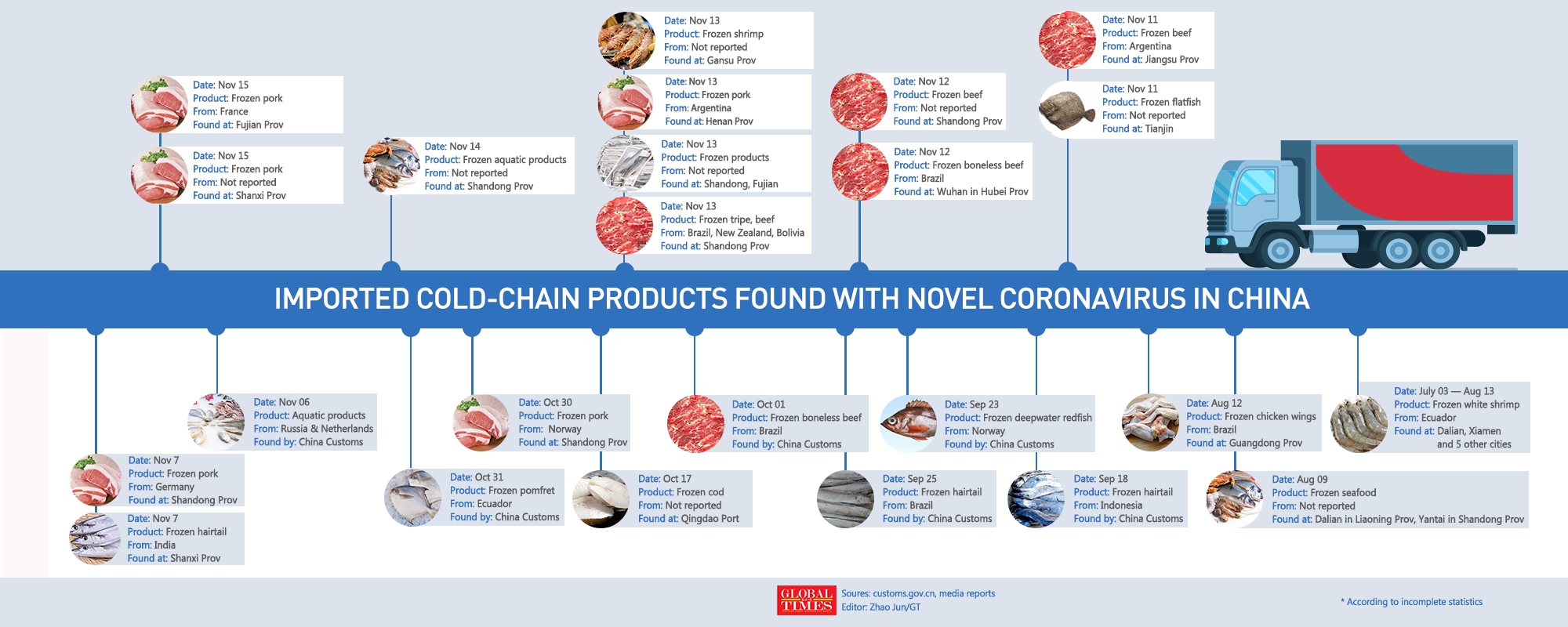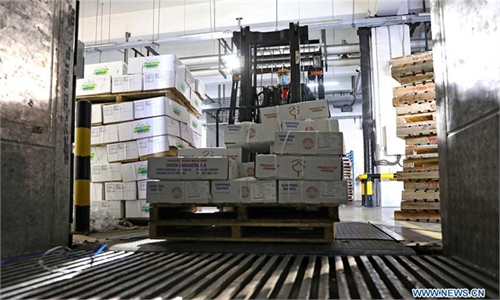Was Wuhan outbreak caused by imported frozen products?
Possibility of overseas source growing with cold-chain infections: experts

Imported cold-chain products found with novel coronavirus in China Illustration: GT
At least 10 Chinese cities have found the inner or outer packages of imported frozen food to be contaminated by the coronavirus at the Customs since June, such as beef from Brazil, pig knuckles from Germany, and shrimp from Brazil and Saudi Arabia, showing the virus could remain alive at low temperatures for a long time.
The East China city of Qingdao reported infections where two "patients zero" of the outbreak in the city worked at a cold storage facility, and tracking of their working environment found contaminated imported frozen cod. North China's Tianjin Municipality in October also found a port loader had been infected.
The cases are strong suggestions that frozen imported food carrying the coronavirus can get people infected, experts said.
The Huanan seafood market in Wuhan also had a number of shops selling imported frozen food, such as king crabs, surf clams, and meat from Brazil and Germany, the Global Times found. The June Beijing outbreak also started from a market that sells not only vegetables and meat, but also imported frozen food.
In the meantime, a new study by the National Cancer Institute of the city of Milan in Italy recently found the novel coronavirus in blood samples collected in October 2019, Reuters reported on Monday. Four volunteers for a lung cancer screening trial had developed antibodies for the coronavirus in early October 2019, much earlier than the discovery of infected cases in Wuhan.
Previous research led by the University of Barcelona in Spain showed the presence of the virus in samples of sewage in the city in March 2019.
"In the past when we did virus tracing, we've always been looking for intermediate hosts, highly likely an animal. It may be time to re-examine whether the outbreak in Wuhan started from one infected person or contaminated food," Yang Zhanqiu, deputy director of the pathogen biology department at Wuhan University, told the Global Times.
The possibility that the Wuhan epidemic was caused by imported frozen food cannot be ruled out if the Huanan seafood market had those products on sale, Wang Guangfa, a respiratory expert at Peking University First Hospital, also told the Global Times.
"Growing evidence showed frozen seafood or meat may have introduced the virus from the epidemic-affected countries into China," Wu Zunyou, the chief epidemiologist at the Chinese Center for Disease Control and Prevention, told the official newspaper of the Communist Party of China Central Commission for Discipline Inspection.
Wu also revealed that COVID-19 patients were concentrated among frozen seafood vendors at Wuhan's Huanan seafood market. As for Beijing's Xinfadi, more cases were found in the seafood zone than in the live fish zone.
But Chinese experts are also cautious in reaching a conclusion because although primary evidence showed similarities between the viral sequences of the Wuhan outbreaks and those found overseas, so far no direct evidence can verify the infection link.
Experts noted Wuhan was the first place that reported an infection, but it doesn't mean the city was the origin of the virus. "The time sequence of reporting a new disease has nothing to do with causality. We have to remain open to tracing," Yang said.
There are still much unknown about the coronavirus and the tracing of the source has not been completed, Chinese top respiratory expert Zhong Nanshan said on Monday.
To prevent further infections being caused by imported food, the Ministry of Transport recently released guidance on how to carry out disinfection of imported food during the process of transportation. The guidance came after China's State Council, the cabinet, released a similar guideline last week.


